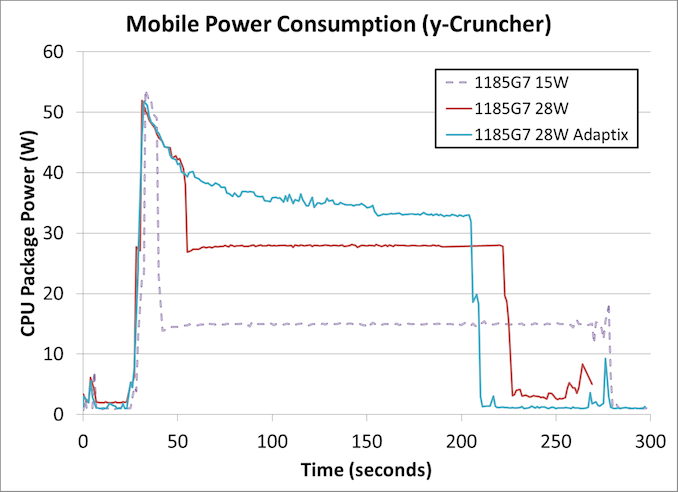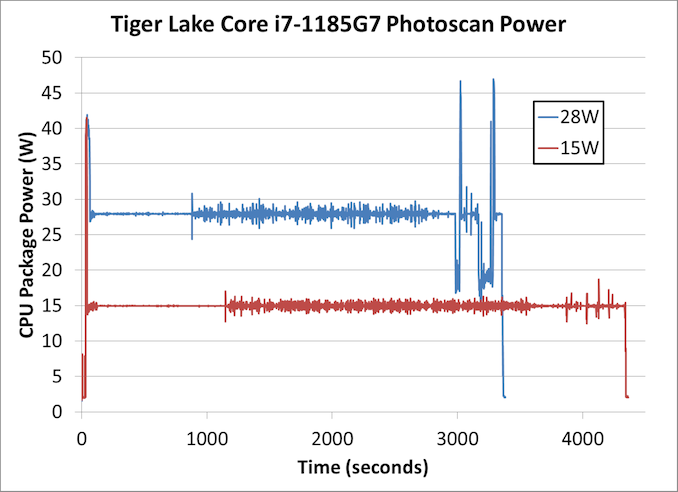Intel’s Tiger Lake 11th Gen Core i7-1185G7 Review and Deep Dive: Baskin’ for the Exotic
by Dr. Ian Cutress & Andrei Frumusanu on September 17, 2020 9:35 AM EST- Posted in
- CPUs
- Intel
- 10nm
- Tiger Lake
- Xe-LP
- Willow Cove
- SuperFin
- 11th Gen
- i7-1185G7
- Tiger King
Comparing Power Consumption: TGL to TGL
On the first page of this review, I covered that our Tiger Lake Reference Design offered three different power modes so that Intel’s customers could get an idea of performance they could expect to see if they built for the different sustained TDP options. The three modes offered to us were:
- 15 W TDP (Base 1.8 GHz), no Adaptix
- 28 W TDP (Base 3.0 GHz), no Adaptix
- 28 W TDP (Base 3.0 GHz), Adaptix Enabled
Intel’s Adaptix is a suite of technologies that includes Dynamic Tuning 2.0, which implements DVFS feedback loops on top of supposedly AI-trained algorithms to help the system deliver power to the parts of the processor that need it most, such as CPU, GPU, interconnect, or accelerators. In reality, what we mostly see is that it reduces frequency in line with memory access stalls, keeping utilization high but reducing power, prolonging turbo modes.
Compute Workload
When we put these three modes onto a workload with a mix of heavy AVX-512 compute and memory accesses, the following is observed.
Note that due to time constraints this is the only test we ran with Adaptix enabled.
This is a fixed workload to calculate 2.5 billion digits of Pi, which takes around 170-250 seconds, and uses both AVX-512 and 11.2 GB of DRAM to execute. We can already draw conclusions.
In all three power modes, the turbo mode power limit (PL2) is approximately the same at around 52 watts. As the system continues with turbo mode, the power consumed is decreased until the power budget is used up, and the 28 W mode has just over double the power budget of the 15 W mode.
Adaptix clearly works best like this, and although it initially follows the same downward trend as the regular 28 W mode, it levels out without hitting much of a ‘base’ frequency at all. Around about the 150 second mark (120 seconds into the test), there is a big enough drop followed by a flat-line which would probably indicate a thermally-derived sustained power mode, which occurs at 33 watts.
The overall time to complete this test was:
- Core i7-1185G7 at 15 W: 243 seconds
- Core i7-1185G7 at 28 W: 191 seconds
- Core i7-1185G7 at 28 W Adaptix: 174 seconds
In this case moving from 15 W to 28 W gives a 27% speed-up, while Adaptix is a total 40% speed-up.
However, this extra speed does come at the cost of total power consumed. With most processors, the peak efficiency point is when the system is at idle, and while these processors do have a good range of high efficiency, when the peak frequencies are requested then we are in a worst case scenario. Because this benchmark measures power over time, we can integrate to get total benchmark power consumed:
- Core i7-1185G7 at 15 W: 4082 joules
- Core i7-1185G7 at 28 W: 6158 joules
- Core i7-1185G7 at 28 W Adaptix: 6718 joules
This means that for the extra 27% performance, an extra 51% power is used. For Adaptix, that 40% extra performance means 65% more power. This is the trade off with the faster processors, and this is why battery management in mobile systems is so important - if a task is lower priority and can be run in the background, then that is the best way to do it to conserve battery power. This means things like email retrieval, or server synchronization, or thumbnail generation. However, because users demand the start menu to pop up IMMEDIATELY, then user-experience events are always put to the max and then the system goes quickly to idle.
Professional ISV Workload
In our second test, we put our power monitoring tools on Agisoft’s Photoscan. This test is somewhat of a compute test, split into four algorithms, however some sections are more scalable than others. Normally in this test we would see some sections rely on single threaded performance, while other sections use AVX2.
This is a longer test, and so the immediate turbo is less of a leading factor across the whole benchmark. For the first section the system seems content to sit at the respective TDPs, but the second section shows a more variable up and down as power budget is momentarily gained and then used up immediately.
Doing the same maths as before,
- At 15 W, the benchmark took 4311 seconds and consumed 64854 joules
- At 28 W, the benchmark took 3330 seconds and consumed 92508 joules
For a benchmark that takes about an hour, a +30% performance uplift is quite considerable, however it comes at the expense of +43% power. This is a better ratio than the first compute workload, but still showcases that 28 W is further away from Tiger Lake’s ideal efficiency point.
Note that the power-over-time graph we get for Agisoft on a mobile processor looks very different to that of a desktop processor, as a mobile processor core can go above the TDP budget with fewer threads.
This leads to the dichotomy of mobile use cases with respect to the marketing that goes on for these products - as part of the Tiger Lake launch, Intel was promoting its use for streaming, professional workflows such as Adobe, video editing and content creation, and AI acceleration. All of these are high-performance workloads, compared to web browsing or basic office work. Partly because Tiger Lake is built on the latest process technology, as well as offering Intel’s best performing CPU and GPU cores, the product is going to be pitched in the premium device market for the professionals and prosumers that can take advantage.












253 Comments
View All Comments
Rtx dude - Monday, September 28, 2020 - link
Thank youStingkyMakarel - Friday, September 18, 2020 - link
anyone tried running multiple single threaded app on Intel and AMD?dsplover - Friday, September 18, 2020 - link
Yes. A couple actually which each get a Core assignment. I’m an audio geek that came from using a PC for streaming from HDD’s (Seagate 10k SCSI Cheetahs) to a software based synthesizer enthusiast where single core performance is crucial.Started with AMD MPs/Tyan Tiger and Coppermine 1GHz CPU’s.
I’ve concluded that CPU Cache or 4.4GHz on an Intel is optimal.
Latency from extra cores causes me to adjust audio buffer sizes to compensate which I noticed on the Intel Quads. Conroe Dual Cores were faster for my core locked synths. A larger CPU cache overcame the inefficiencies when i7 Bloomdales hit the market.
Matisse 3800X was a great chip, but more than the 8 Cores was the same latency issues.
Looking forward to the Cezanne and maybe a Vermeer as I don’t need killer graphics, 2D is fine. Actually AST ASpeed 2500 Server chips on Supermicro and ASRock workstation/server boards is fine.
What I seek is the single core performance crown. Intel i7 4790k’s are still in my racks. To make me jump to new builds is a larger cache from Intel. Tiger Lake at 50watts looks great for my needs. 4.4GHz is as good as it gets. But even my ancient i7 5775C using a discrete GFX card, using the 128MB L4 cache for audio (running at 3.3GHz) was on par with the 4GHz 4790k.
So for me the CPU/IPC gains are appreciated, but cache and CPU running at 4+ GHz are really beneficial.
Tiger Lake or Cezanne will finally show me the results I need to upgrade.
Intel and AMD can add all of the Cores they want. Single core performance or larger cache to overcome the latency of additional Cores will mean I can run more high end Filters to shape my sounds with.
dromoxen - Saturday, September 19, 2020 - link
For me these are still too weak GFx despite 2x .. When they can match or better my gtx960 they might have a customer. Otherwise I''ll stick to a downclocked ryzen 4000+gtx960 ..I want low low heat output , and a single APU would be ideal ..ASROCK deskmini styleee .Gondalf - Friday, September 18, 2020 - link
Not only but the claimed 10/15% IPC boost of Zen 3 will be barely enough to be near with Intel clock to clock. Still Intel process clock clearly better, so the upcoming 8 cores Tiger Lake will be an easy winner over an eight core Zen 3.To be noticed, in productive benches Intel core destroy badly Zen. Likely the cache structure is done to perform great on standard laptop SW.
As usual a core have to be SW optimized, definitively not synthetic benches optimized. More or less the reason Xeon is right now a big winner on Epyc in the 32 cores/cpu market (the larger).
Spunjji - Friday, September 18, 2020 - link
You say this every time a new AMD processor is due, and every time you're wrong, and the next time you say the same damned things again. 😑close - Friday, September 18, 2020 - link
Subjective opinion time. Ian & Andrei, leaving aside individual scores (great ST performance for Intel, great MT performance for AMD), which one would you buy for day to day "regular" work?I've read opinions like "I made it painfully clear that the top-of-the-line Intel CPU at its highest cTDP was only going up against a mid-grade Ryzen" and there's still room for personal opinion here. Should you have to buy one now "money no issue" and ignoring specialized fields (like AI stuff where AVX-512 makes sense) which would you put your money on?
Spunjji - Friday, September 18, 2020 - link
I look forwards to the day when this Intel shill troll gets banned.melgross - Sunday, September 20, 2020 - link
Oh, come on. We have both AMD and Intel trolls here. They cancel out.Spunjji - Sunday, September 20, 2020 - link
There's being a fanboy, then there's creating an entire alter ego as some desperate attempt at satire that is inherently self-satirizing of the person running the account. I find this one deeply tiresome.